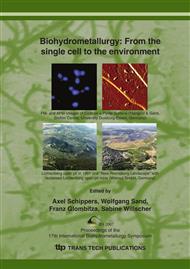p.586
p.589
p.599
p.603
p.607
p.611
p.615
p.619
p.623
Sorption of Co Ions on Biogenic Mn Oxides Produced by a Mn-Oxidizing Fungus, Paraconiothyrium sp.-like Strain
Abstract:
Sorption of Co(II) on the biogenic Mn oxide produced by a Paraconiothyrium sp.-like strain was investigated. The biogenic Mn oxide, which was characterized to be poorly crystalline birnessite (Na4Mn(III) 6Mn(IV) 8O27 ·9H2O) bearing Mn(III) and Mn(IV) in the structure, showed approximately 6.0-fold higher efficiency for Co(II) sorption than a synthetic Mn oxide. XP-spectra of Co 2p for the biogenic and synthetic Mn oxides after Co(II) sorption indicate that Co was immobilized as Co(III) on the surface of Mn oxides, clearly suggesting that redox reaction occurs between Co(II) ions and each Mn oxides. The Co(II) ions would be initially sorbed on the vacant sites of the surface of biogenic Mn oxide, and then oxidized to Co(III) by neighbor Mn(III/IV) atoms to release Mn(II). For the synthetic Mn oxide, release of Mn(II) was negligibly small because the oxidant is only Mn(IV) in ramsdellite (γ-MnO2). The Mn(II) release from the biogenic Mn oxide during Co(II) adsorption would be not only from weakly bounded Mn(II), but also from redox reaction between Mn(III/IV) and Co(II) ions.
Info:
Periodical:
Pages:
607-610
Citation:
Online since:
July 2007
Authors:
Price:
Сopyright:
© 2007 Trans Tech Publications Ltd. All Rights Reserved
Share:
Citation:


